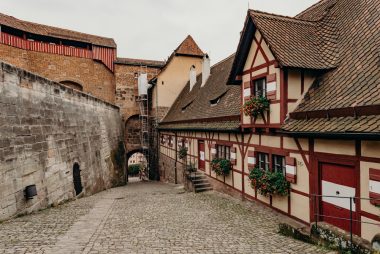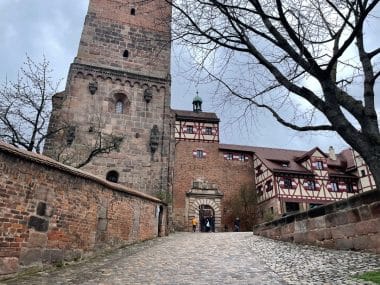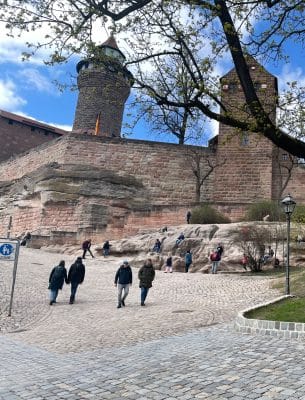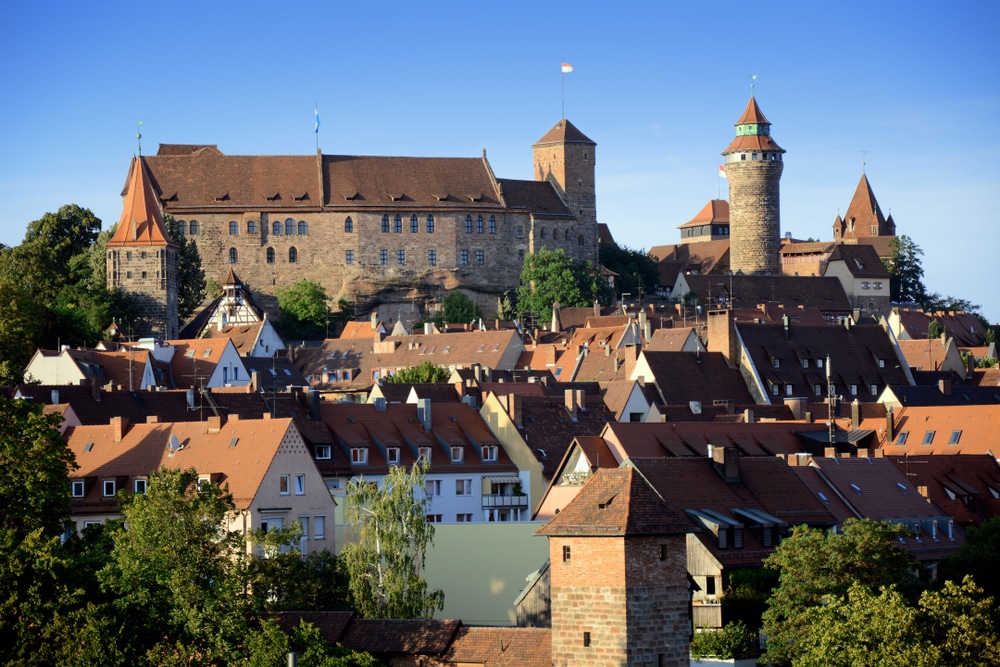The Nuremberg Imperial Castle is located on a small sandstone ridge and overlooks Sebald’s old town and the craftsmen’s quarter of Nuremberg. It forms part of the city fortifications and borders on the Neutorgraben and the Vestnertorgraben. The first written mention of the castle can only be found in documents from 1105, when King Henry V was able to conquer the fortifications. In the next 500 years, the castle was of enormous importance, because all emperors and kings of the Holy Roman Empire spent their time here, at least for a short time. It can be assumed that the castle had even existed a good 100 years earlier. Archaeological investigations have also provided evidence that there are also earlier buildings below the castle, which can be dated to before 1000 AD.
The history of Nuremberg Castle
After the conquest of the castle by King Henry V, it was owned by the Salians for a little more than 100 years. In 1138, however, it was lost to the Swabian rulers. Under this reign, the importance of the castle grew massively. Numerous reconstruction measures were accompanied by a restructuring of the surrounding county. The decline of the Hohenstaufen dynasty brought with it renewed battles for the castle and changing owners, until the castle had finally lost its importance in the 16th century. Nevertheless, some other important episodes in the history of the castle should be mentioned. During the Thirty Years’ War, for example, an unsuccessful siege of Nuremberg and the castle took place. At the beginning of the 19th century, Nuremberg Castle was handed over to the Kingdom of Bavaria, which in turn had to give up control of the castle after a defeat by the Prussians. Damage caused to the castle during the two world wars has now been restored, so that the castle has become a popular destination for tourists.
Important buildings of Nuremberg Castle

Exhibitions in the Imperial Castle Nuremberg

The history of the Imperial Castle
The Imperial Castle, whose origins date back to the 11th century, was one of the most important castles of the Holy Roman Empire during the Middle Ages.
It served as a residence for German kings and emperors and was a symbolic center of imperial power.
In the 13th century, Nuremberg was elevated to the status of an imperial city, and the castle became one of the central places for imperial diets and court days.
During the Second World War, the Imperial Castle was badly damaged, but in the post-war years, extensive restoration ensured that the castle shines in its historic glory.
Today, it is a popular tourist destination and a place where the history of the Middle Ages comes alive.
Important sights of the Imperial Castle
The Imperial Castle consists of several important buildings and areas to discover:
1. The Palas
The Palas, the main building of the castle, served as the residence of the kings and emperors.
Inside, there are now several rooms that can be visited, including the Knights’ Hall and the Emperor’s Hall.
The exhibition in the Palas offers a deep insight into life at court and the history of the Holy Roman Empire.
2. The Double Chapel
The double chapel of St. Margaretha is another highlight of the castle.
It is divided into two floors – the lower floor for the people and the upper floor for the nobility and the emperor.
The Romanesque architecture and well-preserved decorations make the chapel an architectural masterpiece.
3. The Sinwell Tower
The Sinwell Tower, an imposing round tower, is the tallest structure in the Imperial Castle.
Visitors can climb the tower and enjoy a magnificent view of the city of Nuremberg and the surrounding area from the observation deck.
In the Middle Ages, the tower served as a watchtower and protection against enemy attacks.
4. The Deep Well
The Deep Fountain is one of the most impressive technical achievements of the Imperial Castle.
With a depth of about 50 meters, it was vital for the water supply of the castle inhabitants during the sieges.
A guided tour allows a fascinating look into the depths of the fountain and the medieval technology behind it.
5. The Castle Garden
The castle garden, which surrounds the Imperial Castle, is a beautiful place to relax and offers a green oasis above the rooftops of the city, especially in spring and summer.
The gardens are freely accessible and offer picturesque views of Nuremberg.
Opening hours and admission prices

- Summer (April to September): 9:00 a.m. – 6:00 p.m.
- Winter (October to March): 10:00 a.m. – 4:00 p.m.
Admission to the Imperial Castle includes access to the main buildings, the museum, and the Sinwell Tower:
- Adults: 7 EUR
- Concessions (pupils, students, seniors): 6 EUR
- Children (under 18 years): free admission
In addition, there are special combination tickets that include admission to the Imperial Castle and other sights in Nuremberg.
Guided tours and special exhibitions
For visitors who want to learn more about the history of the Imperial Castle, guided tours are regularly offered in several languages.
These tours offer more in-depth information about the architecture, political events and life at the castle.
The Museum of the Imperial Castle also has special exhibitions that deal with various aspects of medieval life and Nuremberg’s role in the Holy Roman Empire.
These exhibitions are a must, especially for history buffs.
Tips for visitors
- Best time to visit: Early in the morning or late afternoon to avoid the crowds.
- View over Nuremberg: The Sinwell Tower offers the best view over the city – well worth the climb!
- Culinary tip: Combine a visit to the castle with a walk through the old town and try Nuremberg specialties such as the famous grilled sausages.


